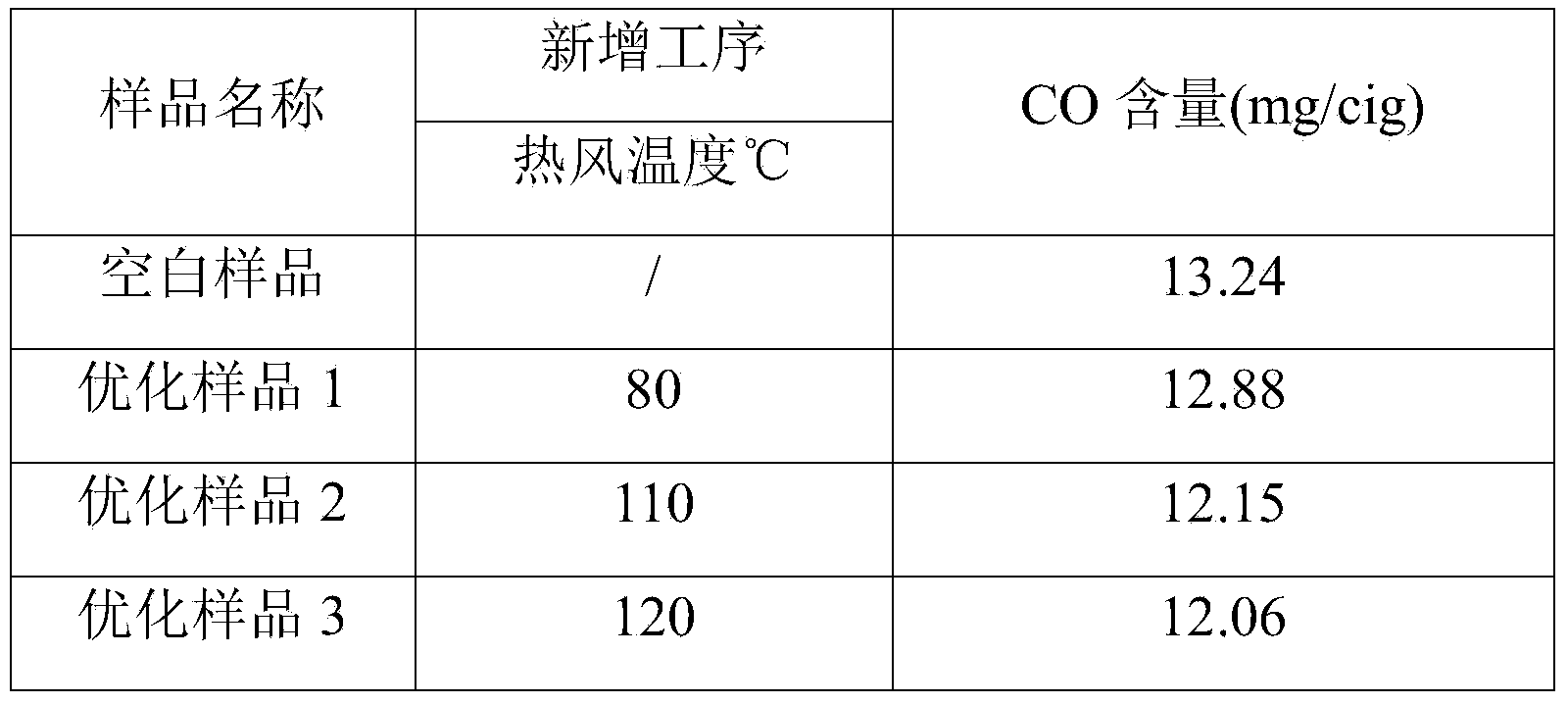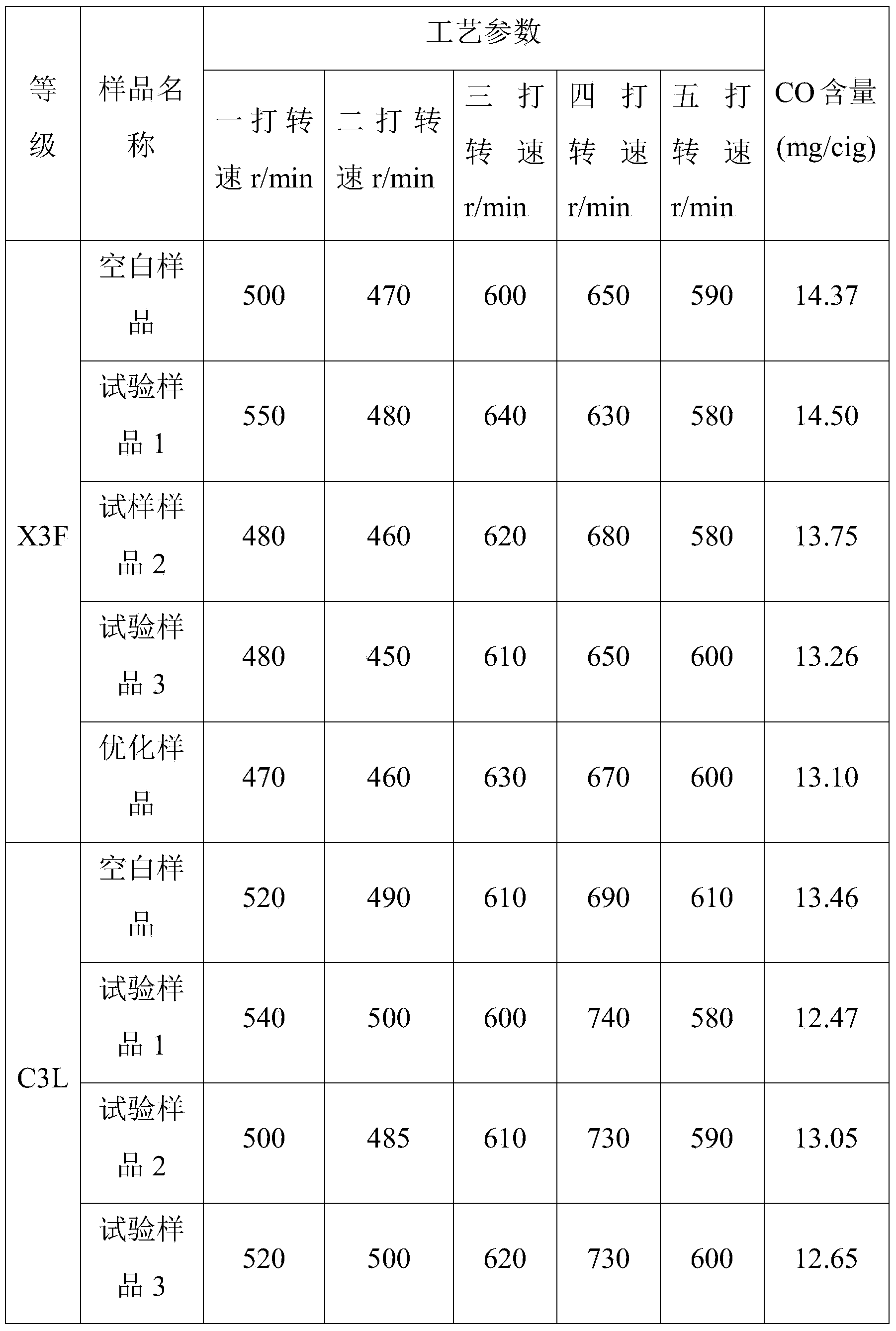Threshing and redrying method for reducing CO release amount
A technology of threshing and re-roasting and release, which is applied in the direction of tobacco preparation, application, tobacco, etc., can solve the problems that have not been paid attention to, and there are no related patents and literature reports, so as to reduce the release of CO and optimize the process The effect of the parameter
- Summary
- Abstract
- Description
- Claims
- Application Information
AI Technical Summary
Problems solved by technology
Method used
Image
Examples
Embodiment 1
[0025] The tobacco leaf samples produced according to the existing threshing and redrying process parameters were used as blank samples; among them, for the B3F tobacco leaves in a certain place in 2011, a new heating and air-moisturizing process was added, and the tobacco leaf samples produced were optimized samples. The two groups of tobacco leaf samples were loosened, re-moisturized, shredded, and air-dried under the same conditions, and then rolled into cigarette samples. The CO content in the smoke of the two samples was detected in Table 1.
[0026] Table 1: CO content detection results of B3F optimized samples and blank samples
[0027]
[0028] It can be seen from Table 1 that under the new treatment process conditions, the CO content in the flue gas of the tobacco samples produced by this method is 8.91% lower than that of the blank sample, which has an obvious effect of reducing the CO content.
Embodiment 2
[0030] The tobacco leaf sample produced according to the existing threshing and re-baking process parameters is used as a blank sample; in the threshing air classification process, the lower tobacco leaves are X3F in a certain place in 2011, the middle tobacco leaves are C3L in a certain place in 2011, and the upper tobacco leaves are B3F in a certain place in 2011. Adjust the process parameters according to the combination of optimized processing process parameters, and the remaining process process parameters remain unchanged, and the tobacco leaf samples produced are optimized samples; the tobacco leaf samples of each group are loosely rehydrated, shredded, and naturally air-dried under the same conditions, and rolled into cigarette samples. The CO content in the flue gas of the samples is shown in Table 2.
[0031] Table 2: Detection results of CO content in optimized samples and blank samples
[0032]
[0033]
[0034] It can be seen from Table 2 that the CO content...
Embodiment 3
[0036] The tobacco leaf sample produced according to the existing threshing and redrying process parameters is used as a blank sample; in the tobacco sheet redrying process, the lower tobacco leaves are X3F in a certain place in 2011, the middle tobacco leaves are C3L in a certain place in 2011, and the upper tobacco leaves are B3F in a certain place in 2011. The process parameters were adjusted according to the combination of optimized processing process parameters, and the process parameters of other processes were kept unchanged, and the tobacco leaf samples produced were optimized samples; the tobacco leaf samples of each group were loosely rehydrated, shredded, and naturally air-cured under the same conditions, and the cigarette samples were rolled. The CO content in the flue gas of the samples is shown in Table 3.
[0037] Table 3: Detection results of CO content in samples optimized for rebaking process and blank samples
[0038]
[0039]
[0040] It can be seen f...
PUM
 Login to View More
Login to View More Abstract
Description
Claims
Application Information
 Login to View More
Login to View More - R&D
- Intellectual Property
- Life Sciences
- Materials
- Tech Scout
- Unparalleled Data Quality
- Higher Quality Content
- 60% Fewer Hallucinations
Browse by: Latest US Patents, China's latest patents, Technical Efficacy Thesaurus, Application Domain, Technology Topic, Popular Technical Reports.
© 2025 PatSnap. All rights reserved.Legal|Privacy policy|Modern Slavery Act Transparency Statement|Sitemap|About US| Contact US: help@patsnap.com



